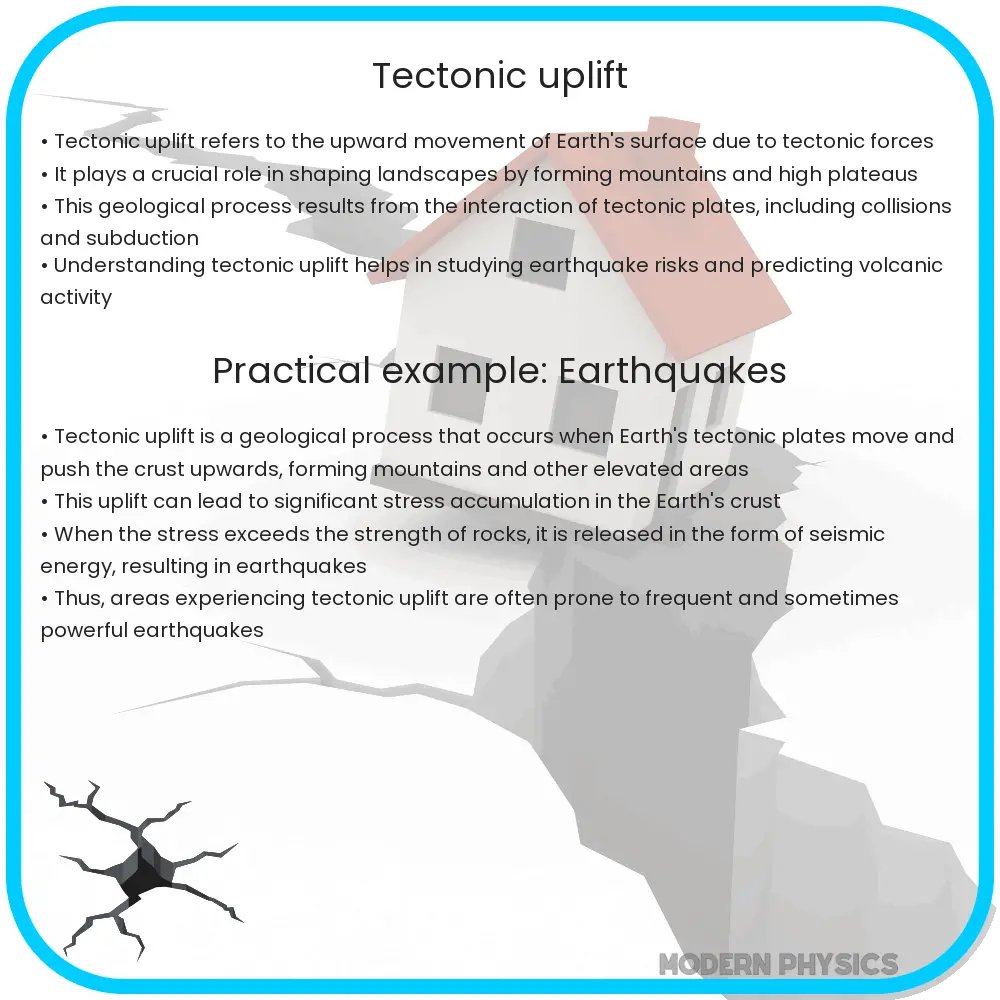Learn about tectonic uplift, the vertical rise of Earth’s surface due to internal geophysical processes, shaping landscapes and affecting climates.

Understanding Tectonic Uplift: Causes and Implications
Tectonic uplift refers to the vertical rise of Earth’s surface, primarily driven by geophysical processes within the Earth’s crust. This phenomenon plays a key role in shaping landscapes, influencing climate patterns, and affecting ecological systems. By exploring the causes and effects of tectonic uplift, we can gain deeper insights into Earth’s dynamic geology and its interaction with the environment.
Causes of Tectonic Uplift
The primary cause of tectonic uplift is the movement of tectonic plates. The Earth’s lithosphere is divided into several plates that float on the semi-fluid asthenosphere beneath them. The interactions among these plates can lead to various forms of uplift. There are majorly three types:
- Convergent Boundaries: When two tectonic plates collide, they form convergent boundaries. Depending on the nature of the plates involved, this can lead to the uplifting of mountain ranges. For example, the Himalayas have been formed due to the collision between the Indian Plate and the Eurasian Plate.
- Rifting: This occurs when tectonic plates move apart from each other. The tensional forces create fractures, allowing the Earth’s crust to stretch and thin out, causing vertical movement. An example of rifting is the East African Rift system, which is actively extending and elevating parts of the Eastern African plateau.
- Hotspots and Volcanic Activity: Tectonic uplift can also be caused by volcanic activity, particularly in regions over hotspots – areas where hot mantle plumes rise towards the surface. The Hawaiian Islands are an example of islands formed by volcanic eruptions that have also contributed to the uplift of the ocean floor.
Another significant factor contributing to tectonic uplift is isostatic adjustments. This is the process by which the Earth’s crust strives to maintain gravitational equilibrium. When there is erosion or ice melting in certain areas, the crust tends to rebound, leading to an uplift, which adjusts to the decrease in surface weight.
Effects of Tectonic Uplift
The phenomena of tectonic uplift have numerous implications for the environment and human populations. Here are some key effects:
- Formation of Natural Landscapes: Many of Earth’s mountain ranges, plateaus, and other land features are a direct result of tectonic uplift. These features not only dictate regional climates but also influence weather patterns over broader areas.
- Impacting Biodiversity: As mountains and highlands form, they create varied habitats and microclimates. This diversity often leads to speciation, where new species evolve to adapt to these unique environments.
- Resource Distribution: Tectonic uplift can expose underground resources, like minerals and fossil fuels, making them accessible for extraction and use. However, these processes can also disrupt ecosystem services and lead to environmental concerns.
In understanding these mechanisms and implications, geophysicists deploy various measures which will be explored in the continuation of this article.
Understanding Tectonic Uplift Through Geophysical Measures
Geophysicists employ a variety of techniques to study and interpret the events and consequences of tectonic uplift. These methods provide critical data that enhance our understanding of Earth’s structural behavior and its impacts on the environment.
- Seismic Reflection and Refraction: These methods involve sending shockwaves into the Earth and analyzing how they are reflected or refracted by different geological structures. This helps to map subterranean structures and identify zones of potential uplift.
- GPS and Remote Sensing: Modern technology allows scientists to use GPS and satellite images to measure the precise amount of uplift occurring over time. These techniques are crucial in monitoring changes and predicting future movements.
- Geological Mapping: Detailed maps of geological formations provide insights into historical uplift events and help predict areas where future uplift might occur. This is essential for planning and mitigating potential natural disasters.
These techniques not only assist in understanding the dynamics of tectonic uplift but also play a pivotal role in planning and development activities in uplift-prone areas, thus protecting life and property from possible adverse effects.
Conclusion
Tectonic uplift is a powerful force that shapes our planet in many profound ways. It forms majestic landscapes, determines biodiversity, and influences global climate systems. By studying the causes of tectonic uplift, such as plate tectonics, rifting, and volcanic activities, and observing its effects through advanced geophysical techniques, scientists can better predict and mitigate its impacts.
The ongoing research and monitoring are essential as they provide the knowledge required to manage the Earth’s resources sustainably and prepare for natural phenomena that could affect human populations. Understanding tectonic uplift, therefore, not only satisfies scientific curiosity but also serves a practical purpose in our quest to coexist harmoniously with our dynamic planet.
